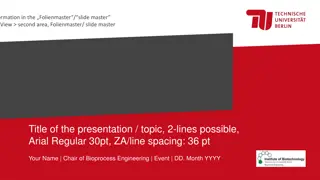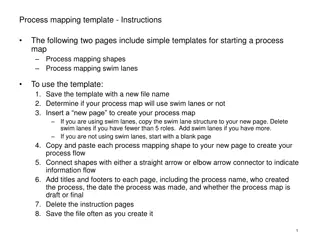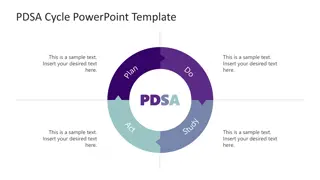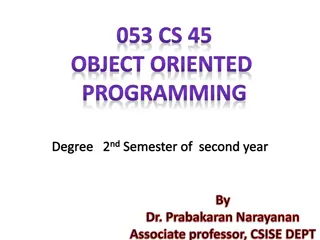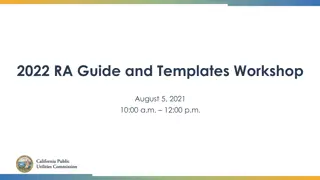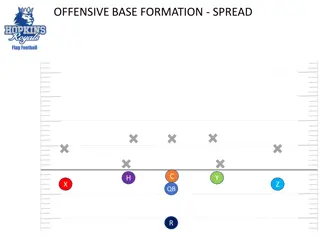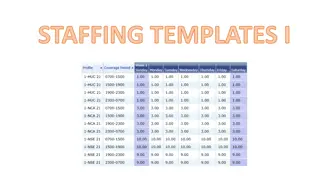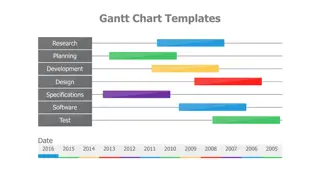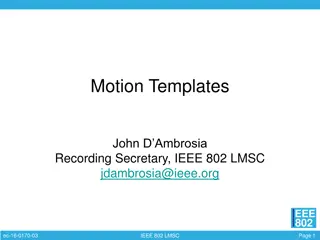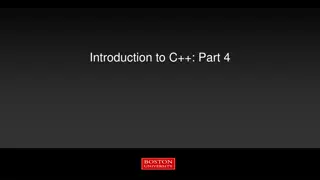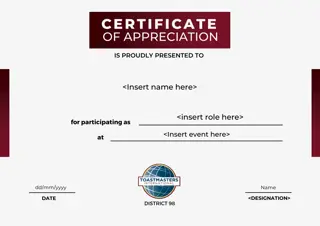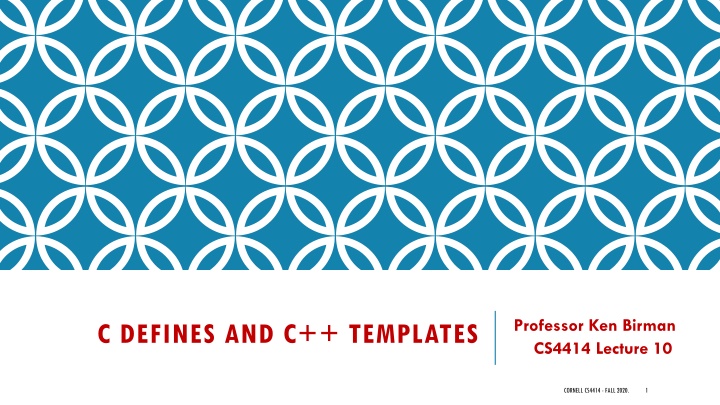
Mastering C++ Templates: Empowering Compile-Time Computing
Explore the power of C++ templates in enabling compile-time computing, enhancing performance, and improving code structuring. Learn how templates in C++ revolutionize the way we program by controlling the compiler and leveraging the templating layer for speed and predictability.
Download Presentation

Please find below an Image/Link to download the presentation.
The content on the website is provided AS IS for your information and personal use only. It may not be sold, licensed, or shared on other websites without obtaining consent from the author. If you encounter any issues during the download, it is possible that the publisher has removed the file from their server.
You are allowed to download the files provided on this website for personal or commercial use, subject to the condition that they are used lawfully. All files are the property of their respective owners.
The content on the website is provided AS IS for your information and personal use only. It may not be sold, licensed, or shared on other websites without obtaining consent from the author.
E N D
Presentation Transcript
Professor Ken Birman CS4414 Lecture 10 C DEFINES AND C++ TEMPLATES CORNELL CS4414 - FALL 2020. 1
COMPILE TIME COMPUTING In lecture 9 we learned about const, constexpr and saw that C++ really depends heavily on these Ken s solution to homework 2 runs about 10% faster with extensive use of these annotations Constexpr underlies the auto keyword and can sometimes eliminate entire functions by precomputing their results at compile time. Parallel C++ code would look ugly without normal code structuring. Const and constexpr allow the compiler to see beyond that and recognize parallelizable code paths. CORNELL CS4414 - FALL 2020. 2
BUT HOW FAR CAN WE TAKE THIS IDEA? Today we will look at the concept of programming the compiler using the templating layer of C++ We will see that it is a powerful tool! There are also programmable aspects of Linux, and of the modern hardware we use. By controlling the whole system, we gain speed and predictability while writing elegant, clean code. CORNELL CS4414 - FALL 2020. 3
IDEA MAP FOR TODAY History of generics: #define in C Templates are easy to create, if you stick to basics The big benefit compared to Java is that a template is a compile-time construct, whereas in Java a generic is a run-time construct. We have seen a number of parameterized types in C++, like std::vector and std::map The template language is Turing-complete, but computes only on types, not data from the program (even when constants are provided). These are examples of templates . They are like generics in Java CORNELL CS4414 - FALL 2020. 4
CONCEPT OF A GENERIC OR TEMPLATE A class that can be specialized by providing element types as class arguments. For example, a list of pets or a map from strings to counters This separates the abstraction the class implements from the specific types of objects it manages. CORNELL CS4414 - FALL 2020. 5
EARLY HISTORY OF GENERICS Many trace their roots to C, the original language introduced with Unix (which was the original Linux) C++ still has C as a subset C++ will compile a C program. But C lacked classes, so object oriented coding was infeasible CORNELL CS4414 - FALL 2020. 6
C INTRODUCED A SIMPLE FORM OF MACRO SUBSTITUTION The most basic option just defines a replacement rule: #define SOMETHING something-else But this wasn t enough, and people added parameters #define SOMETHING(x) something-else that uses x CORNELL CS4414 - FALL 2020. 7
EXAMPLES Examples using #define #define OPT1 0x00001 #define DEBUGMODE 1 #define SIGN(x) (x < 0: -1: 1) #define ERRMSG(s) { if(DEBUGMODE) printf(s); } CORNELL CS4414 - FALL 2020. 8
ONE USE OF #DEFINE(T) WAS FOR TYPES Allows a library method to be specialized for a single type. But C code gets confusing if #define(T) is respecialized for multiple uses in different places. For example, if you use #define(T) Pet to specify the type in a list of pets, you wouldn t also be able to have a list of desserts. CORNELL CS4414 - FALL 2020. 9
IN FACT, THE C PREPROCESSOR DOES MORE #if, #else/#elif, #endif offer some limited compile-time control. The dead code vanishes, and the compiler never even sees it. Typical uses: compile one version of the code if the computer has a GPU, a different version if it lacks a GPU. Or have debugging logic that vanishes when we aren t testing. CORNELL CS4414 - FALL 2020. 10
BUT THEY ARE TOO LIMITED As noted, we couldn t create a type that can be parameterized with types of objects using it, or that it holds. And we can t reason about types in #if statements, which have very limited conditional power. All of these limitations frustrated C users. C++ to the rescue! CORNELL CS4414 - FALL 2020. 11
WHILE ALL OF THIS WAS PLAYING OUT, LANGUAGES BECAME OBJECT ORIENTED Java was the first widely successful OO language, but in fact there were many prior attempts. Java used pragmas and annotations for some roles similar to what C did with #define, #if, etc. A very large community began to use objects but early decisions resulted in runtime reflection overheads (discussed previously)! CORNELL CS4414 - FALL 2020. 12
JAVA POLYMORPHISM Allows a single method with a single name to have varying numbers of arguments, and varying argument types. The compiler had the task of matching each invocation to one of the polymorphic variants. CORNELL CS4414 - FALL 2020. 13
JAVA GENERICS In the early versions of Java, a class such as list or a hash map would just treat the values as having object type . This, though, is impossible to type check: is this a list that only includes animals that can bark, or might it also have other kinds of animals on it, or even non-animals? Java generics solved that problem, but Java retained the older form of unresolved object types as a form of legacy. CORNELL CS4414 - FALL 2020. 14
THE POWER OF GENERICS In fact Java s generics are amazingly powerful. You can literally load a Java JAR file, see if it implements class List with objects that all support operations Bark, Sit, LieDown, etc, and if so, call them. This is done using runtime reflection in which a program can take a reference to a class (even one loaded from a JAR file) and enumerate over the variables, types and methods it defines CORNELL CS4414 - FALL 2020. 15
THE ISSUE WITH JAVA GENERICS The language never eliminated the universal object class, which is the common supertype for all the more specific Java classes. As a result, Java needed an instanceof test, as well as other features, so that the runtime can figure out what types of objects it is looking at (for runtime type checking) and also which method to call (for polymorphic method invocations) CORNELL CS4414 - FALL 2020. 16
C++ TEMPLATE GOALS When C++ was designed, the owners of its template architecture were aware of the C and Java limitations. They wanted to find a pure way to express the same concepts while also programming in an elegant, self-explanatory way, and they wanted to do this without loss of performance. CORNELL CS4414 - FALL 2020. 17
TEMPLATES AND POLYMORPHISM IN C++ Polymorphic method calls, but resolved at compile time. Extensible classes, but flexible and able to look at object types and generate different logic for different types. C++ lacks the equivalent of the Java runtime instanceof . It does have a compile time instanceof. In C++ all types are fully resolved at compile time. Every C++ object has a single and very specific type CORNELL CS4414 - FALL 2020. 18
TEMPLATES AND POLYMORPHISM IN C++ in fact, even polymorphism in C++ is resolved at compile time! C++ is always able to identify the specific method instance to call. C++ even dynamically loads libraries without worrying that somehow the library methods won t be what it expects. CORNELL CS4414 - FALL 2020. 19
TEMPLATES AND POLYMORPHISM IN C++ but there is one powerful feature that is very much like polymorphism: inheritance of fully virtual classes In C++ we often define a virtual class that describes a standard set of methods shared across some set of different classes. So for example, IBark could be an interface shared by animals that know how to bark , with a method bark . CORNELL CS4414 - FALL 2020. 20
TEMPLATES AND POLYMORPHISM IN C++ For example: class line : public shape { public: virtual ~line(); virtual void move_x(int x); // implements move_x virtual void move_y(int y); // implements move_y virtual void draw(); // implements draw private: point end_point_1, end_point_2; //... }; class shape // An interface class { public: virtual ~shape() {}; virtual void move_x(int x) = 0; virtual void move_y(int y) = 0; virtual void draw() = 0; //... }; CORNELL CS4414 - FALL 2020. 21
TEMPLATES AND POLYMORPHISM IN C++ IShape but in fact, there is no rule Some developers prefer names like Says that any class inheriting the shape interface must define this method. For example: Tells C++ that this is supposed to match a virtual method inherited from some other class (in our case, from shape ) class line : public shape { public: virtual ~line(); virtual void move_x(int x); // implements move_x virtual void move_y(int y); // implements move_y virtual void draw(); // implements draw private: point end_point_1, end_point_2; //... }; class shape // An interface class { public: virtual ~shape() {}; virtual void move_x(int x) = 0; virtual void move_y(int y) = 0; virtual void draw() = 0; //... }; We are looking at line.hpp, which has the type signature but not the implementation. Line.cpp is required to implement line::move_x(int x), etc. CORNELL CS4414 - FALL 2020. 22
FULLY VIRTUAL CLASSES ARE INHERITED BY CONCRETE CLASSES A class like Dog would inherit a fully virtual class like IBark. Dog would then need to provide implementations (code bodies) for the IBark methods. CORNELL CS4414 - FALL 2020. 23
TEMPLATES ALSO HAVE A FORM OF COMPILE- TIME INSTANCEOF FEATURE You can check to see if a type has some specific characteristic and generate code conditional on that. For example, a template could check to see if the given type supports IBark and if so, call the bark method. But then if not, it could check for IPurr. And then for IChirp This all occurs when the template is instantiated at compile time CORNELL CS4414 - FALL 2020. 24
C++ TEMPLATES Botton line: they can do everything Java generics can do, but at compile time, and also cover defines, varargs, etc. We will start with simpler cases that you might often want to use, then will just skim the fancier things seen in C++ libraries, but that normal mortals don t normally need to actually do. CORNELL CS4414 - FALL 2020. 25
SUMMARY OF TEMPLATE GOALS Compile time type checking and type-based specialization. A way to create classes that are specialized for different types Conditional compilation, with dead code automatically removed Code polymorphism and varargs without runtime polymorphism CORNELL CS4414 - FALL 2020. 26
C++ ADVANTAGE? It centers on the compile-time type resolution. Impact? The resulting code is blazingly fast. In fact, C++ wizards talk about the idea that at runtime, all the fancy features are gone, and we are left with plain old data and logic that touches that data mapped to a form of C. The job of C++ templates is to be as expressive as possible without ever requiring any form of runtime reflection. CORNELL CS4414 - FALL 2020. 27
THE BASIC IDEA IS EXTREMELY SIMPLE As a concept, a template could not be easier to understand. Suppose we have an array of objects of type int: int myArray[10]; With a template, the user supplies a type by coding something like Things<long>. Internally, the class might say something like: T myArray[10]; CORNELL CS4414 - FALL 2020. 28
THE BASIC IDEA IS EXTREMELY SIMPLE As a concept, a template could not be easier to understand. Suppose we have an array of objects of type int: int myArray[10]; With a template, the user supplies a type (T) and we express this by just coding: T myArray[10]; T behaves like a variable, but the value is some type, like int or Bignum CORNELL CS4414 - FALL 2020. 29
TO ACCESS THIS FUNCTIONALITY, YOU CREATE A TEMPLATE FOR A CLASS template<typename T> class Things { T myArray[10]; T getElement(int); void setElement(int,T); } CORNELL CS4414 - FALL 2020. 30
YOU CAN ALSO SUPPLY A CONSTANT template<class T, const int N> class Things { T myArray[N]; T getElement(int); void setElement(int,T); } CORNELL CS4414 - FALL 2020. 31
TEMPLATED FUNCTIONS Templates can also be associated with individual functions. The entire class can have a type parameter, but a function can have its own (perhaps additional) type parameters Template<typename T> T max(T a, T b) { return a>b? a : b; // T must support a > n }
FUNCTION TEMPLATES Nothing special has to be done to use a function template int main(int argc, char* argv[]) { int a = 3, b = 7; double x = 3.14, y = 2.71; } cout << max(a, b) << endl; cout << max(x, y) << endl; cout << max(a, x) << endl; // Instantiated with type int // Instantiated with type double // ERROR: types do not match Note that in these examples, the type is automatically inferred by C++
CLASS TEMPLATES template <class T> class myarray { private: T* v; int sz; public: myarray(int s) { v = new T [sz = s]; } // Constructor myarray(const myarray& b) { v = b.v; sz = b.sz; }// Copy constructor ~myarray() { delete[] v; } // Destructor T& operator[] (int i) { return v[i]; } size_t size() { return sz; } }; You can instantiate the same templated class with different types myarray<int> intArray(10); myarray<shape> shapeArray(10);
Developer of this class wanted T to be a class type (not a base type like int, double, etc) CLASS TEMPLATES template <class T> class myarray { private: T* v; int sz; public: myarray(int s) { v = new T [sz = s]; } // Constructor myarray(const myarray& b) { v = b.v; sz = b.sz; }// Copy constructor // Destructor Syntax is fine, but gives a compilation error: int is a type, but it is not a class type (not a C++ object) ~myarray() { delete[] v; } T& operator[] (int i) { return v[i]; } size_t size() { return sz; } }; You can instantiate the same templated class with different types myarray<int> intArray(10); myarray<shape> shapeArray(10);
TYPEDEF Typedef allows you to give a short name to a type that might otherwise require a long name. Examples: typedef vector<int> VecInt; typedef map<string, tuple<double, int, float, MyClass> > MyTuple;
USING IS SIMILAR TO TYPEDEF Syntax is using name = type; Can appear in a template definition (1) using name = type ; (2) template < template-parameter-list > using name = type ;
TEMPLATE TYPES CAN BE CONSTRAINED Suppose that we want to build a template for a class with a method speak() that calls bark() . Dogs and seals bark. Cats do not. So we might want to restrict our template type: template<typename T> requires T instanceof(Ibark) CORNELL CS4414 - FALL 2020. 38
TEMPLATE TYPES CAN BE CONSTRAINED We might even want to implement a given function in a different way for different types of objects. You could do this using instanceof inline in your code, but it is handled at compile time. This rule introduces some complications. C++ has many options; we will just look at one of them. See https://en.cppreference.com/w/cpp/language/constraints CORNELL CS4414 - FALL 2020. 39
REQUIRES This clause allows you to say that the template type must implement some interface. This says that the template is only valid for classes that define equality testing, or for types that are aliases of the void type. template<typename T> requires EqualityComparable<T> || Same<T, void> https://en.cppreference.com/w/cpp/language/constraints CORNELL CS4414 - FALL 2020. 40
VARIABLE ARGUMENT LISTS Methods with variable numbers of arguments are also a traditional source of confusion in strongly typed languages. In C, there are many methods like printf: printf( In zipcode %5d, today s high will be %3.1f\n , local_zipcode, local_temperature); notice that the format expects specific types of arguments! CORNELL CS4414 - FALL 2020. 41
VARARGS ARE HARD TO TYPE CHECK In Java, varargs can easily be supported using object type, and there are standard ways to iterate over the arguments supplied But this means we are forced to do runtime type checking later, when trying to do something to those objects, like convert to a string for printing. C++ wanted this same power with strong compile-time typing CORNELL CS4414 - FALL 2020. 42
IN C, THIS CAN SIMPLY RESULT IN BUGS If the temperature passed to this printf, in C, is of type int or some form of low-precision float type, printf will just print a nonsense output. The C++ designers wanted generics to also address this issue, and they came up with an insane concept (that works): one version of printf (or whatever) for every sequence of types actually used in the code. Polymorphism to the max! CORNELL CS4414 - FALL 2020. 43
WHAT??? Consider this case: printf( %d,%f,%d,%s\n , 2, 3.0, 4, 5.7 ); C has many other methods like this, including ones that arise in totally different situations (for example to handle networking addresses, which come in many flavors, like IPv4 versus IPv6). CORNELL CS4414 - FALL 2020. 44
WHAT??? printf( %d,%f,%d,%s\n , 2, 3.0, 4, 5.7 ); The idea in C++ was to allow such things, but translate them to runtime code that has one version of the method (printf, in our example) for each type actually used: printf(char *format, int i0, float f0, int i1, char* s0) { } printf(char *format, float f0, int i1, char* s0) { } printf(char *format, int i1, char* s0) { } CORNELL CS4414 - FALL 2020. 45
WASTE OF SPACE? Computers have a lot of memory, and you aren t likely to really use a million permutations of types. Code is fairly compact. So they concluded that no, this won t waste space. And it does allow for very effective type checking, at compile time! CORNELL CS4414 - FALL 2020. 46
VARIADIC TEMPLATES The idea is a bit brain bending ! But this feature is a form of compile-time recursion in the template language system, and it allows you to handle variable argument lists with different types for each item. For printf: we end up with a series of printf calls, each for a single argument. CORNELL CS4414 - FALL 2020. 47
HERES SAFE_PRINTF // In the .hpp file, this comes first, so that // C++ will know how to compile the lone call to // safe_printf with no arguments, when it sees it. void safe_printf(const char *s) { // We processed all the arguments, scan remainder while (*s) { if (*s == '%') { if (*(s + 1) == '%') { ++s; } else { throw "invalid format: missing arguments"; } } std::cout << *s++; } } template<typename T, typename... Args> void safe_printf(const char *s, T& value, Args... args) { while (*s) { // Scan up to the next format item if (*s == '% ) { // found it if (*(s + 1) == '%') { ++s; } else { // Really should check that *s matches T std::cout << value; // call even when *s == 0 to detect extra arguments safe_printf(s + 1, args...); return; } } std::cout << *s++; // Output text part of the format } throw "extra arguments provided to printf"; } Recursive Case CORNELL CS4414 - FALL 2020. 48 Base Case
KEY TO UNDERSTANDING THIS TEMPLATE It creates a whole series of printf methods, each calling the next one, for use with this specific sequence of types template<typename T, typename... Args> void safe_printf(const char *s, T& value, Args... args) { std::cout << value; // At this point C++ knows value is of type T! safe_printf(s + 1, args...); // We ve removed one argument } CORNELL CS4414 - FALL 2020. 49
KEY TO UNDERSTANDING THIS TEMPLATE It creates a whole series of printf methods, each calling the next one, for use with this specific sequence of types Template expansion will replace these with a series of properly typed parameters, each with an automatically generated name template<typename T, typename... Args> void safe_printf(const char *s, T& value, Args... args) { std::cout << value; // At this point C++ knows value is of type T! safe_printf(s + 1, args...); // We ve removed one argument } CORNELL CS4414 - FALL 2020. 50



